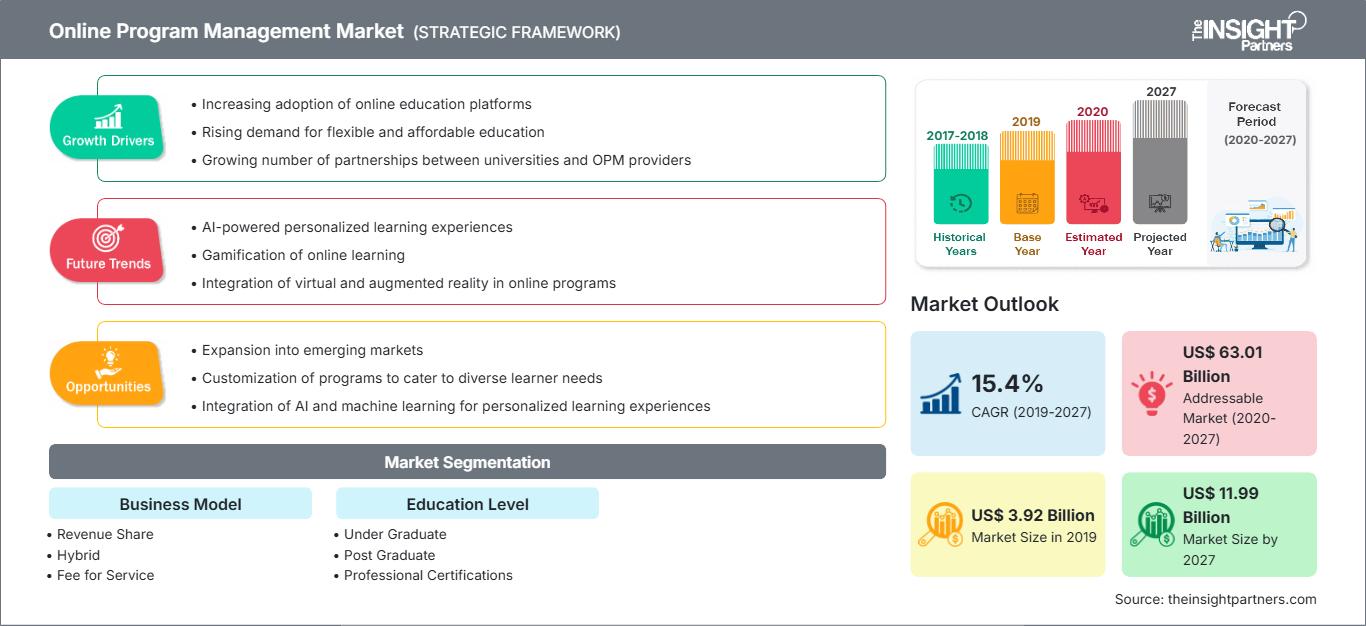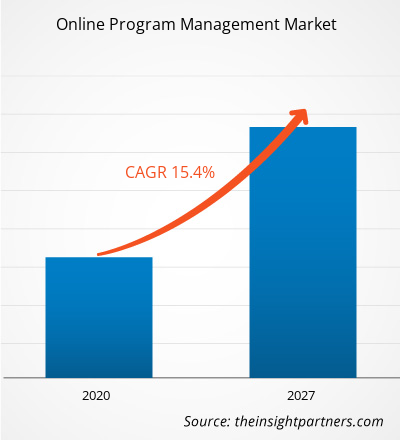Der Markt für Online-Programmmanagement wurde 2019 auf 3.916,3 Mio. US-Dollar geschätzt und soll von 2020 bis 2027 mit einer durchschnittlichen jährlichen Wachstumsrate von 15,4 % wachsen und bis 2027 11.986,4 Mio. US-Dollar erreichen.
Online-Programmmanagement (OPM) umfasst die Unterstützung von Studierenden, die Bearbeitung von Anmeldungen, die Durchführung von Marktforschung und -analysen und bietet die neueste Marketing-Technologie-Infrastruktur. Das am Online-Programmmanagement beteiligte Team besteht aus Experten für digitales Marketing, Datenanalysten, Bildungstechnologen, Webentwicklern und Spezialisten für die Studentenbetreuung, um einen reibungslosen Ablauf für Studierende zu gewährleisten. Online-Abschlüsse sind mittlerweile weit verbreitet und werden von mehreren Hochschulen und Universitäten angeboten. Jedes Jahr schreiben sich Studierende aller Einrichtungen für Online-Kurse ein. Der Markt für Online-Programmmanagement ist ein stark fragmentierter und wettbewerbsintensiver Markt. Da führende Unternehmen in diesem Markt ihren Zielmarkt durch die Erweiterung ihres Angebots und die Diversifizierung ihres Kundenstamms kontinuierlich erweitern, sehen sich alle wichtigen Akteure einem zunehmenden Wettbewerb sowohl durch Start-ups als auch durch führende etablierte Unternehmen weltweit ausgesetzt. Mehrere Unternehmen in der Wertschöpfungskette übernehmen andere Marktteilnehmer, um ihre Marktposition zu behaupten und ihren Kunden effiziente Dienstleistungen zu bieten. Die wichtigsten Anbieter von Online-Programmmanagement haben ihren Sitz in Nordamerika, vor allem in den USA. Der Markt wächst jedoch stark in der APAC-Region.
Verschiedene Unternehmen in Nordamerika bieten Online-Programmmanagement-Lösungen für Hochschulen und Universitäten an, die im Bildungssektor breite Akzeptanz finden. Die steigende Nachfrage nach E-Learning und die zunehmende Bedeutung effektiven Lernens beflügeln das Wachstum des Bildungsmarktes in der Region. Zunehmende staatliche Initiativen, wie z. B. die staatlichen Studienförderungsprogramme, und der zunehmende Trend, technologische Fortschritte für die Entwicklung innovativer Online-Programmmanagement-Lösungen durch private und öffentliche Einrichtungen zu nutzen, treiben das Wachstum des Online-Programmmanagement-Marktes voran.
Passen Sie diesen Bericht Ihren Anforderungen an
Sie erhalten kostenlos Anpassungen an jedem Bericht, einschließlich Teilen dieses Berichts oder einer Analyse auf Länderebene, eines Excel-Datenpakets sowie tolle Angebote und Rabatte für Start-ups und Universitäten.
Online-Programmmanagement-Markt: Strategische Einblicke

- Holen Sie sich die wichtigsten Markttrends aus diesem Bericht.Dieses KOSTENLOSE Beispiel umfasst Datenanalysen, die von Markttrends bis hin zu Schätzungen und Prognosen reichen.
Markteinblicke: Die steigende Nachfrage nach Online-Bildung treibt das Wachstum des Marktes für Online-Programmmanagement voran.
Sie erhalten kostenlos Anpassungen an jedem Bericht, einschließlich Teilen dieses Berichts oder einer Analyse auf Länderebene, eines Excel-Datenpakets sowie tolle Angebote und Rabatte für Start-ups und Universitäten.
Online-Programmmanagement-Markt: Strategische Einblicke

- Holen Sie sich die wichtigsten Markttrends aus diesem Bericht.Dieses KOSTENLOSE Beispiel umfasst Datenanalysen, die von Markttrends bis hin zu Schätzungen und Prognosen reichen.
Online-Lernen wird zu einem wesentlichen Bestandteil der Bildungslandschaft. Die Einschreibungen in Online-Programme werden zunehmend durch die steigende Zahl von Studierenden vorangetrieben, die nach flexiblen Formaten für Zertifikate, Kurse und Studiengänge suchen, um ihre Berufswahl zu unterstützen und weiterführende Studien zu verfolgen. Studierende, die in Präsenzprogrammen eingeschrieben sind, konzentrieren sich während ihrer Einschreibung auch darauf, sich für Hybrid- bis hin zu reinen Online-Kursen anzumelden. Online-Bachelor-Abschlüsse erfreuen sich unter Studierenden großer Beliebtheit, da viele renommierte und große Institutionen aufgrund der hochwertigen technischen Unterstützung beim Lernen auf verschiedene Online-Studiengänge umsteigen. Darüber hinaus konzentrieren sich die heutigen Doktoranden aktiv darauf, virtuelle Kurse für ihr weiterführendes Studium zu belegen. Beispielsweise erfreut sich das Fernstudium für den MBA-Studiengang zunehmender Beliebtheit, und die Zahl der Online-MBA-Studiengänge verzeichnet Jahr für Jahr ein starkes Wachstum. Die Anmeldungen für derartige Programme an öffentlichen und gemeinnützigen Universitäten nehmen zu, da die Nachfrage nach virtuellen Programmen steigt, was das Wachstum des Marktes für Online-Programmmanagement voraussichtlich vorantreiben wird. Darüber hinaus spielt der steigende Bedarf an berufsbezogener Kompetenzentwicklung und lebenslangem Lernen eine wesentliche Rolle für das Wachstum von Online-Programmen. Für Anbieter von Online-Programmen decken die Käufer von Zertifikatskursen ein großes Segment ab, da viele Studierende Online-Kurse zur Verbesserung ihrer Fähigkeiten wählen, die an Branchenstandards ausgerichtet sind. Durch den Erwerb fachspezifischer Zertifizierungen steigern Fachkräfte ihren Wert für das Unternehmen und ihre Position. Diese anspruchsvolle Entscheidung soll sie zudem über Technologien, Branchentrends und viele andere sich weltweit ständig weiterentwickelnde Themenbereiche auf dem Laufenden halten. Wer sich durch die Wahl verschiedener und geeigneter Kurse weiterbildet und informiert, hat die besten Chancen, seine Karriere voranzutreiben. Beispielsweise haben viele Online-Bildungsportale und Hochschulen aufgrund der wachsenden Beliebtheit von Datenanalyse bei Studierenden eine Reihe von Kursen zu Datenanalyse und Datenmarktforschung entwickelt. Somit fördert die steigende Nachfrage nach Online-Abschlüssen und berufsbegleitenden Kursen das Wachstum des Marktes für Online-Programmmanagement.
Einblicke in Geschäftsmodelle
Im Segment Geschäftsmodelle nimmt der Umsatzanteil den größten Anteil am globalen Markt für Online-Programmmanagement ein. Umsatzanteil ist ein langfristiges, institutionenweites Partnerschaftsmodell, das begrenzte Investitionen von Institutionen für die Durchführung und Aufrechterhaltung des Projekts erfordert. In diesem Modell ist das finanzielle Risiko für die Partnerinstitution begrenzt, da OPM-Anbieter den Großteil des Investitionskapitals bereitstellen.
Einblicke in das Bildungsniveau
Der Markt für Online-Programmmanagement ist nach Anwendung in Bachelor-, Master- und Berufszertifizierungen sowie weitere unterteilt. Das Segment der Masterabschlüsse nimmt den dominierenden Anteil am globalen Markt für Online-Programmmanagement ein.
Auswirkungen von COVID-19 auf den Markt für Online-Programmmanagement
Das Coronavirus hat das Bildungssystem weltweit beeinträchtigt. Dies hat zur Schließung vieler Universitäten und Schulen geführt. Dies hat sich negativ auf den Betrieb von Schulen und Hochschulen ausgewirkt. Als Reaktion auf die Schließungen von Schulen und Universitäten aufgrund von COVID-19 hat die UNESCO empfohlen, für den Fernunterricht offene Bildungsanwendungen und Online-Fernlernprogramme zu nutzen. Dies bietet große Chancen für Anbieter von Online-Programmmanagement-Diensten. Der Mangel an Internetverbindung und unterstützender Infrastruktur bleibt jedoch eine Herausforderung.
Unternehmen verfolgen häufig Fusions- und Übernahmestrategien, um ihre Präsenz weltweit auszubauen und die wachsende Nachfrage zu decken. Diese Strategie ist vor allem in Nordamerika zu beobachten. Einige der jüngsten Übernahmen sind unten aufgeführt:
2018: Wiley übernahm The Learning House, Inc. Dadurch erweiterte das Unternehmen sein Angebot an Online-Programmmanagement-Diensten, darunter Graduierten- und Bachelorprogramme, Kurzkurse, Bootcamps und mehr für internationale Studierende, berufliche Weiterbildungsdienste für Lehrer und mehr.2017: 2U übernahm Get Educated International Proprietary Limited. Das Unternehmen übernahm Get Educated International Proprietary Limited. Infolgedessen verwaltet das Unternehmen seine Geschäftstätigkeit nun über zwei berichtspflichtige Segmente.
Online-Programmmanagement-Markt
Die Analysten von The Insight Partners haben die regionalen Trends und Faktoren, die den Markt für Online-Programmmanagement im Prognosezeitraum beeinflussen, ausführlich erläutert. In diesem Abschnitt werden auch die Marktsegmente und die geografische Lage im Online-Programmmanagement in Nordamerika, Europa, im asiatisch-pazifischen Raum, im Nahen Osten und Afrika sowie in Süd- und Mittelamerika erörtert.Umfang des Marktberichts zum Online-Programmmanagement
| Berichtsattribut | Einzelheiten |
|---|---|
| Marktgröße in 2019 | US$ 3.92 Billion |
| Marktgröße nach 2027 | US$ 11.99 Billion |
| Globale CAGR (2019 - 2027) | 15.4% |
| Historische Daten | 2017-2018 |
| Prognosezeitraum | 2020-2027 |
| Abgedeckte Segmente |
By Geschäftsmodell
|
| Abgedeckte Regionen und Länder | Nordamerika
|
| Marktführer und wichtige Unternehmensprofile |
|
Dichte der Marktteilnehmer im Bereich Online-Programmmanagement: Die Auswirkungen auf die Geschäftsdynamik verstehen
Der Markt für Online-Programmmanagement wächst rasant. Dies wird durch die steigende Nachfrage der Endnutzer aufgrund veränderter Verbraucherpräferenzen, technologischer Fortschritte und eines stärkeren Bewusstseins für die Produktvorteile vorangetrieben. Mit der steigenden Nachfrage erweitern Unternehmen ihr Angebot, entwickeln Innovationen, um den Bedürfnissen der Verbraucher gerecht zu werden, und nutzen neue Trends, was das Marktwachstum weiter ankurbelt.

- Holen Sie sich die Online-Programmmanagement-Markt Übersicht der wichtigsten Akteure
- Umsatzanteil
- Hybrid
- Gebühr für Service
Markt für Online-Programmmanagement – Nach Bildungsniveau
- Grundstudium
- Aufbaustudium
- Berufszertifizierungen
- Sonstige
Globaler Markt für Online-Programmmanagement nach Regionen
Nordamerika
- USA
- Kanada
- Mexiko
Europa
- Frankreich
- Deutschland
- Italien
- Großbritannien
- Russland
- Übriges Europa
Asien-Pazifik
- China
- Indien
- Südkorea
- Japan
- Australien
- Übriger Asien-Pazifik-Raum
Naher Osten & Afrika
- Südafrika
- Saudi-Arabien
- VAE
- Rest des Nahen Ostens und Afrika
Südamerika
- Brasilien
- Argentinien
- Rest Südamerika
Firmenprofile
- 2U, Inc.
- Akademische Partnerschaften
- Apollidon
- Bisk Education, Inc.
- Blackboard Inc.
- Keypath Education
- Noodle Partners
- Online-Bildungsdienste
- PEARSON PLC
- Wiley Education Services
- Historische Analyse (2 Jahre), Basisjahr, Prognose (7 Jahre) mit CAGR
- PEST- und SWOT-Analyse
- Marktgröße Wert/Volumen – Global, Regional, Land
- Branchen- und Wettbewerbslandschaft
- Excel-Datensatz
Aktuelle Berichte
Verwandte Berichte
Erfahrungsberichte
Grund zum Kauf
- Fundierte Entscheidungsfindung
- Marktdynamik verstehen
- Wettbewerbsanalyse
- Kundeneinblicke
- Marktprognosen
- Risikominimierung
- Strategische Planung
- Investitionsbegründung
- Identifizierung neuer Märkte
- Verbesserung von Marketingstrategien
- Steigerung der Betriebseffizienz
- Anpassung an regulatorische Trends






















 Kostenlose Probe anfordern für - Online-Programmmanagement-Markt
Kostenlose Probe anfordern für - Online-Programmmanagement-Markt